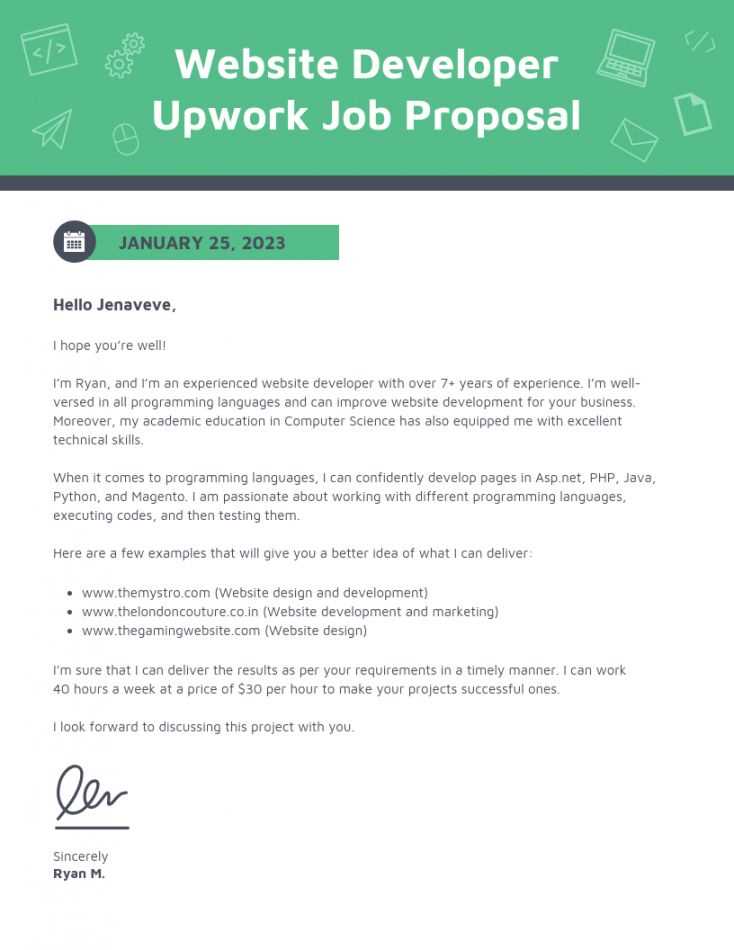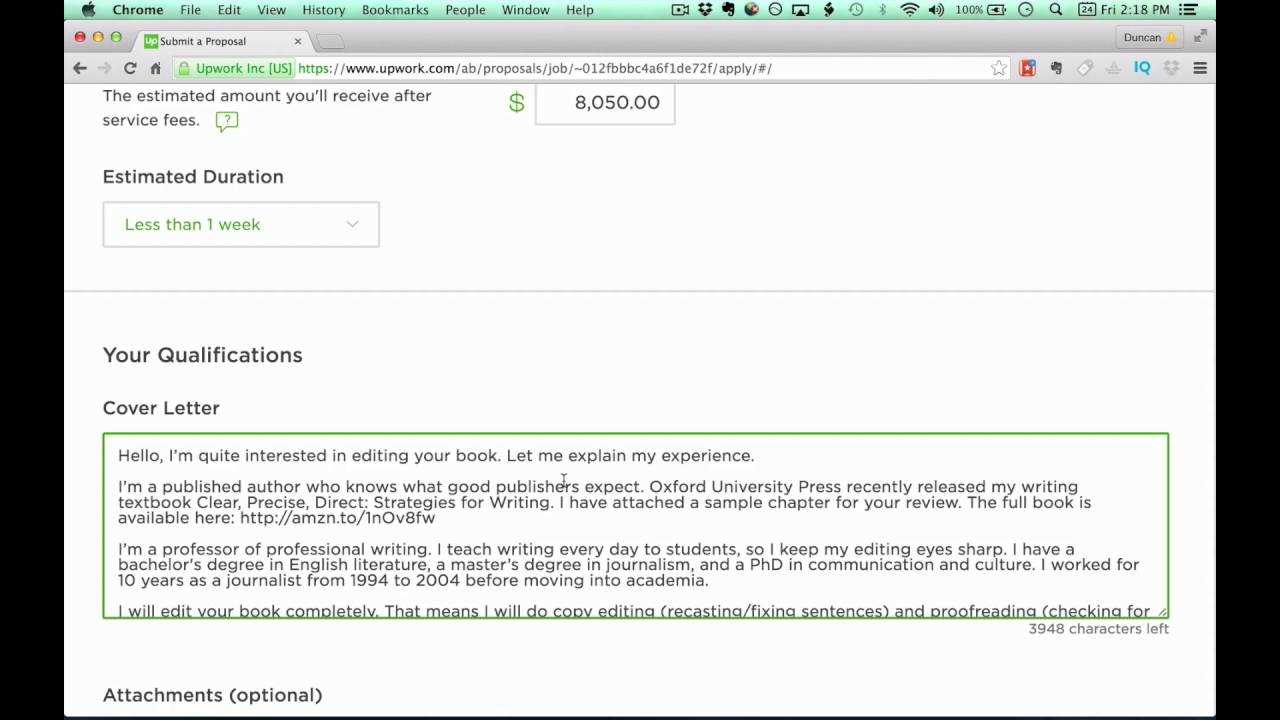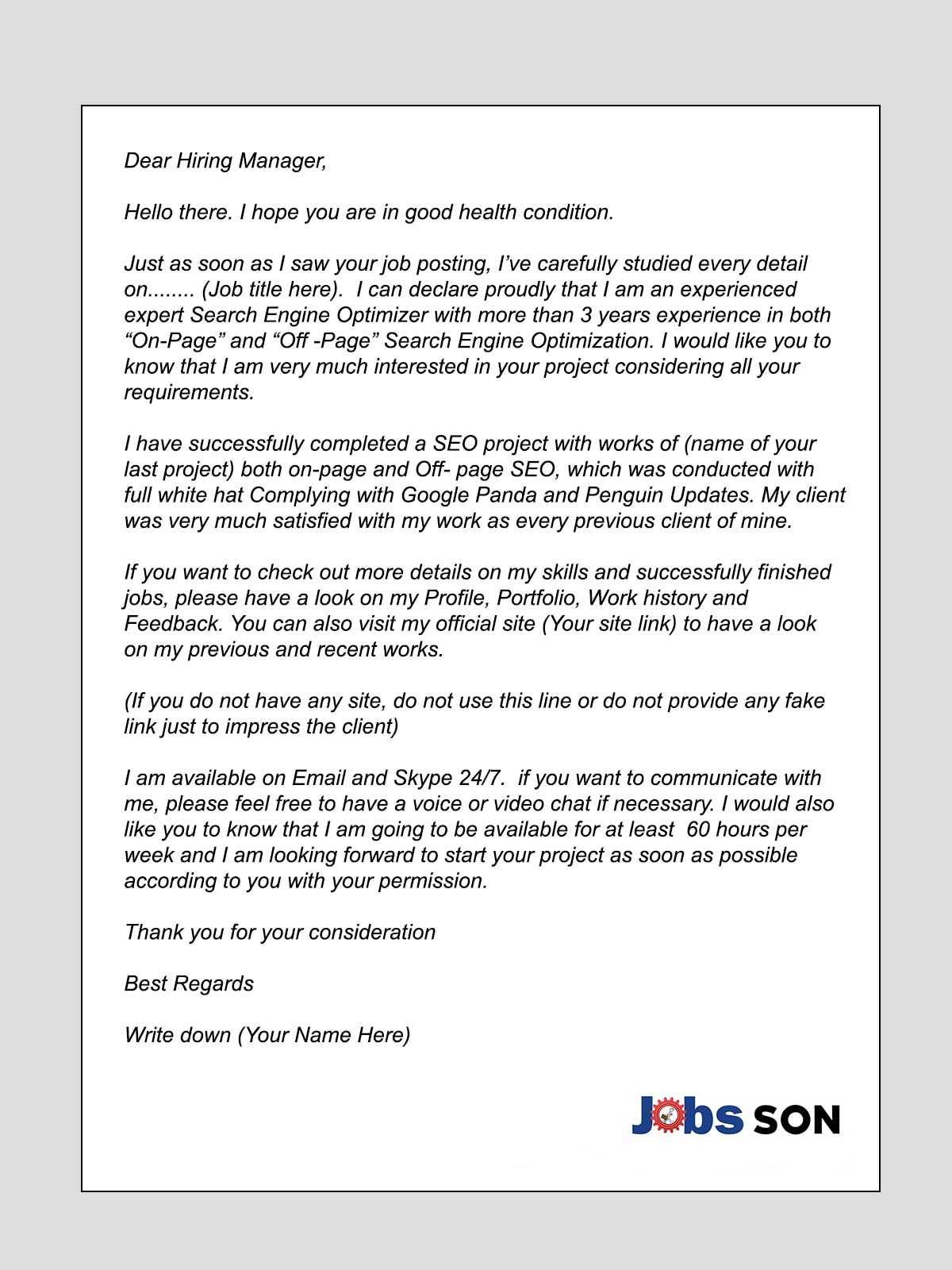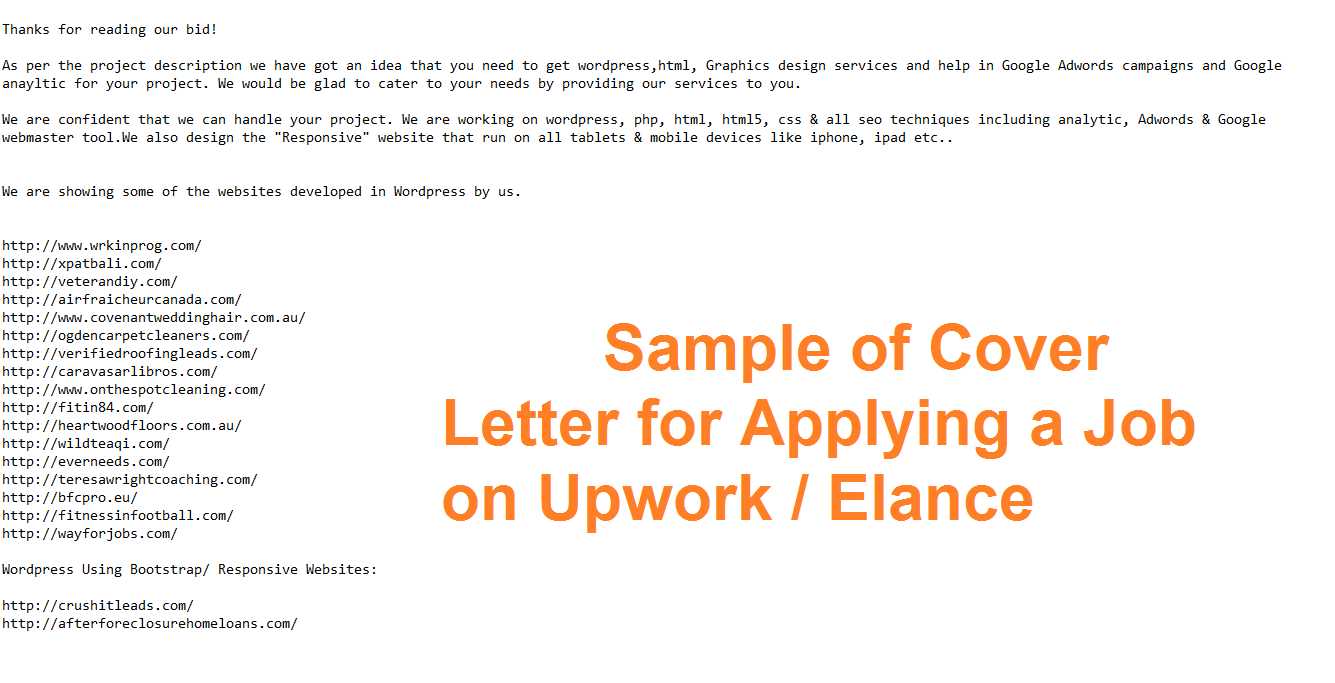Upwork Cover Letter Template for Winning Proposals

When applying for freelance jobs, presenting yourself effectively is crucial. A well-structured and engaging application can significantly increase your chances of standing out among other candidates. It’s important to know how to convey your skills, experience, and enthusiasm in a way that captures the client’s attention right from the start.
One of the best ways to approach this is by creating a tailored document that highlights your strengths while addressing the specific needs of each job posting. This kind of personalized response is far more likely to resonate with potential clients than a generic submission.
By following certain strategies, you can create a professional proposal that speaks directly to the client’s requirements and showcases why you are the best fit for the role. Understanding the key components of a successful submission and learning how to present yourself clearly can make all the difference in securing new projects.
How to Write a Strong Upwork Cover Letter
Crafting a persuasive and professional submission is a key step in making a great impression on potential clients. A strong application should effectively communicate your skills, experience, and enthusiasm for the project. To achieve this, it’s essential to focus on clarity, relevance, and engagement throughout the document.
Here are some important steps to follow:
- Start with a compelling introduction: Address the client directly, mention the project briefly, and express genuine interest in the opportunity.
- Highlight relevant experience: Focus on specific examples from your past work that demonstrate your ability to handle similar tasks successfully.
- Show your understanding of the project: Mention key details from the job description and explain how your skills align with the client’s needs.
- Be concise and to the point: Avoid lengthy paragraphs. Get straight to the core of why you’re the best choice for the job.
- End with a call to action: Encourage the client to take the next step, such as scheduling a meeting or discussing the project further.
By following these guidelines, you can create a document that not only showcases your abilities but also highlights your professional attitude, increasing your chances of standing out and securing the project.
Key Elements of a Perfect Proposal
When submitting an application for a freelance project, it’s essential to structure your response in a way that highlights your strengths while addressing the client’s specific needs. A well-crafted proposal should cover several key components to ensure that you capture the client’s attention and convey your professionalism effectively.
Introduction and Personalization
The first impression is crucial. Start by introducing yourself briefly and mentioning the specific project. Personalize the opening to reflect the client’s requirements, showing that you’ve read the job description thoroughly and are genuinely interested in the project.
Relevant Skills and Experience

Next, highlight your most relevant skills and past experiences. Provide concrete examples of previous work that align with the client’s needs. This demonstrates your ability to handle the task at hand and reassures the client that you have the necessary expertise to succeed.
By including these elements in your application, you’ll create a compelling proposal that stands out and gives you the best chance of securing the project.
Why Customization Matters in Applications
Tailoring your response to each specific job posting is crucial in making a strong impression on potential clients. A generic application can often come across as impersonal or unenthusiastic, whereas one that addresses the unique needs of a project shows that you’ve put in the effort to understand the job and how you can contribute to its success.
Building Trust Through Personalization
Clients are more likely to trust freelancers who take the time to customize their proposals. By acknowledging the client’s specific challenges and demonstrating how your experience or skills can solve their problems, you establish yourself as someone who genuinely understands their needs. This approach helps foster trust and encourages a deeper connection.
Standing Out in a Competitive Market
In a marketplace filled with many applicants, personalization helps you stand out. Generic applications may blend in, while a well-crafted, customized response highlights your unique value proposition. When you focus on the details that matter to the client, you position yourself as the best fit for the role.
Customizing your submissions shows professionalism and increases your chances of success by demonstrating that you are invested in the project and capable of addressing the client’s specific requirements.
Common Mistakes to Avoid in Applications
When submitting a proposal, certain missteps can undermine your chances of success. Avoiding common errors can make the difference between standing out and being overlooked. A well-crafted application should be professional, tailored, and free from mistakes that may diminish your credibility.
Common Pitfalls to Watch Out For
- Using a generic response: Failing to personalize your submission can make you appear uninterested or lazy. Always tailor your message to the specific job and client.
- Overloading with irrelevant details: While it’s important to highlight your skills, avoid including information that isn’t related to the client’s needs. Stick to what matters most.
- Ignoring the client’s instructions: Not following the application instructions closely can suggest that you don’t value the client’s time or that you lack attention to detail.
- Being overly formal or too casual: Striking the right tone is important. Being too formal can make you sound robotic, while being too casual may seem unprofessional.
- Grammatical errors: Mistakes in spelling, punctuation, or grammar can make you seem careless. Always proofread before submitting.
How to Avoid These Mistakes
By paying attention to these potential pitfalls and taking the time to craft a thoughtful, personalized, and error-free application, you can significantly improve your chances of standing out and securing the job. Show the client that you’re detail-oriented and serious about their project.
Improving Your Chances with Effective Templates
Using a well-structured and professional format can help you present yourself clearly and efficiently to potential clients. An effective outline allows you to convey your skills, experience, and enthusiasm in a way that is easy to understand, improving your chances of securing a project. While personalization is essential, having a strong framework in place can save time and ensure consistency across applications.
Benefits of Using a Structured Format
A clear structure enables you to focus on the most important aspects of your submission while making it easier for clients to read. With a solid framework, you can quickly adapt your content to different projects without losing quality or coherence.
Essential Elements to Include in Your Structure
| Element | Description |
|---|---|
| Introduction | Start by addressing the client and briefly introducing yourself and your interest in the project. |
| Relevant Experience | Highlight specific past work that demonstrates your ability to handle the client’s needs effectively. |
| Skills | Emphasize the skills that are most relevant to the job, showing that you have the necessary expertise to succeed. |
| Call to Action | Encourage the client to move forward with the discussion, such as scheduling an interview or reviewing your portfolio. |
By using a well-organized format, you can ensure that your submissions are clear, concise, and compelling, giving you an edge in a competitive market.
How to Tailor Your Proposal for Clients

Customizing your application for each specific client is essential to create a strong, personal connection. When you align your message with the client’s unique needs and expectations, you show that you are invested in the project and capable of delivering exactly what they require. This approach greatly increases your chances of standing out from the competition.
Understand the Client’s Requirements
Before crafting your response, carefully read the job description and identify the client’s pain points and desired outcomes. By addressing these directly, you demonstrate that you understand their challenges and can offer practical solutions tailored to their specific situation. Avoid generic statements and focus on how your skills and experiences will directly benefit their project.
Show Your Commitment to Their Success

Clients want to feel confident that you are not just another freelancer but someone who genuinely cares about their success. Use personalized language to express your enthusiasm for the project and highlight how you can help them achieve their goals. By emphasizing your commitment to their success, you create a stronger bond and build trust, making you a more attractive candidate.
Best Practices for Professional Writing on Upwork
Effective communication is crucial when working on freelancing platforms. The way you present yourself in written form plays a significant role in attracting clients and building lasting relationships. Writing professionally not only conveys your expertise but also demonstrates your commitment to high standards and clear communication.
Maintain Clarity and Conciseness
Clients appreciate responses that are easy to read and straight to the point. Avoid overly complex language and keep your sentences clear and concise. Focus on delivering the most important information in a structured way, which makes it easier for clients to understand your qualifications and interest in the project without being overwhelmed by unnecessary details.
Be Polite and Respectful
In professional writing, tone matters greatly. Always maintain a polite and respectful tone, even if you are discussing challenges or offering feedback. Clients appreciate a positive attitude and a willingness to collaborate. Using respectful language creates a foundation for a productive working relationship and helps build trust.